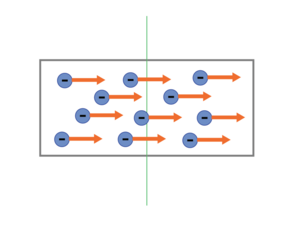Current
Claimed by Jack Serketich Spring 2022
Current is the rate of flow of charged particles through a conductive material, such as metal. These charged particles can be many different things, but for this curriculum, you only need to be aware of electrons. This flow goes from an area of high electric potential to low electric potential. Current is measured in Amperes (A).
The Main Idea

Most commonly used in circuits and magnetic field problems, current is a driving force for many occurrences in physics. The flow of electrons can power devices through its transfer of energy or create a cylindrical magnetic field due to its numerous moving charges. Current is denoted by an uppercase I and is measured in the SI unit of Amperes, or amps (A), which describe the amount of charge that passes a cross-section of a wire per second, and therefore has units of coulombs per second. In circuits, current is created by a battery or voltage source creating a potential difference in either end of a wire(s). This puts the circuits you will largely be focusing on in a steady state, not equilibrium.
Current is commonly described in its conventional form. Conventional current was coined by Benjamin Franklin before the true direction of current was found. He made the convention of current in a simple sircuit flowing from an area of high electric potential to low electric potential, believing protons were the charge carriers. However, it was later discovered that electrons are the charge carriers and flow from an area of low electric potential to high electric potential. This means the conventional current and electron current oppose each other. Charge carriers can also be positive, however, such as a semiconductor which can have positive or negative carriers. Physicists ultimately decided to continue with conventional current to prevent confusion. For the sake of this curriculum, we will follow the conventional current model unless specified otherwise.
Current is a major component in Ohm's Law, helping us understand how electrons move within circuits. Its magnetic fields are frequently used throughout the course.
A Mathematical Model
In this curriculum, current will only need to be calculated in terms of Ohm's Law and its magnetic field. While you do not need to understand the following equations to understand the course's material, it may aid in your understanding.
Assume uniform density [math]\displaystyle{ n }[/math] of mobile electrons (uniform current) moving with an average drift speed [math]\displaystyle{ v }[/math] in a wire of cross-sectional area [math]\displaystyle{ A }[/math]
[math]\displaystyle{ i=density⋅area⋅length/time = nAv }[/math]
with units of
[math]\displaystyle{ electrons/m^3⋅m^2⋅m/s=electrons/s }[/math]
Since I (conventional current) is defined as the amount of charge moving past a point per second, we multiply the number of electrons by positive charge [math]\displaystyle{ |q| }[/math] to get:
[math]\displaystyle{ I = |q|⋅i = |q|nAv }[/math]
with units of
[math]\displaystyle{ coulombs⋅electrons/s = C/s = Amperes }[/math]
Another way to express the formulas for current is in terms of the electron mobility [math]\displaystyle{ μ }[/math]of the material and the electric field [math]\displaystyle{ E }[/math] inside the metal. This can be done by recognizing that the average drift speed [math]\displaystyle{ v = μE }[/math]. Substituting this into the equations for electron and conventional current, we get:
[math]\displaystyle{ i = nAv = nAμE }[/math] (electron current)
and
[math]\displaystyle{ I = |q|nAv = |q|nAμE }[/math] (conventional current)
If a charge distribution of density [math]\displaystyle{ ρ }[/math] moves with the velocity [math]\displaystyle{ v }[/math], the charge per unit time through [math]\displaystyle{ ΔA }[/math] is [math]\displaystyle{ ρv⋅nΔA }[/math] [math]\displaystyle{ Δq=ρv⋅nΔAΔt }[/math]. [math]\displaystyle{ ρ = Nq }[/math]
The charge per unit time is then [math]\displaystyle{ ρv⋅nΔS }[/math], from which we get the current density to be [math]\displaystyle{ Nqv }[/math]
The current I through the surface is [math]\displaystyle{ I=∫Nqv⋅dA }[/math]
Other useful mathematical relationships of [math]\displaystyle{ I }[/math] in circuits are
[math]\displaystyle{ I = ΔV/R }[/math]
where [math]\displaystyle{ ΔV }[/math] is the potential difference and [math]\displaystyle{ R }[/math] is the resistance in ohms. and
[math]\displaystyle{ P = I⋅ΔV }[/math]
where [math]\displaystyle{ P }[/math] is the power of a circuit component.
In summary,
[math]\displaystyle{ i = nAv = nAμE }[/math] (electron current)
[math]\displaystyle{ I = |q|nAv = |q|nAμE }[/math] (conventional current)
[math]\displaystyle{ I = ΔV/R }[/math]
[math]\displaystyle{ P = I⋅ΔV }[/math]
A Computational Model
To view this code, go to GlowScript.org.
# GlowScript 1.1 VPython
n = 10 #number of electrons
r = 1.5 #radius of wire
A = pi * r**2 #area of wire
v = 2 #drift velocity
q = 1.602e-19
#calculate current
I = q * n * A * v
print("Current Calculation: q * n * A * v")
print("Current Calculation: " + q + " * " + n + " * (" + A + ") * " + v)
print("Current is: " + I)
#the wire that the current will flow through
wire = cylinder(pos=vec(-5, 0, -5), axis=vec(5, 0, 5), radius = r)
#make electrons
lengthOffset = vec(8 / sqrt(2) / n, 0, 8 / sqrt(2) / n)
rotateList = [vec(0, 0.65, 0) * r, vec(-0.2 * sqrt(2), -0.4, 0.2 * sqrt(2)) * r, vec(0.2 * sqrt(2), -0.2, -0.2 * sqrt(2)) * r]
electronList = []
for i in range(0, n):
electronList.append(sphere(pos = rotateList[i % 3] - lengthOffset * i, radius = 0.2, color = color.blue, og = rotateList[i % 3]))
#move electrons
while True:
rateNum = 100
rate(rateNum) #this says 100 calculations per second
for electron in electronList:
electron.pos = electron.pos + vec(v * (1/rateNum) / sqrt(2),0,v * (1/rateNum) / sqrt(2))
if sqrt(electron.pos.x**2 + electron.pos.z**2) > 8:
electron.pos = electron.og
Examples
Simple
One type of problem you are sure to encounter involves a battery and resistor. You can read more about that section on the RC circuit or Ohm's Law page of this wiki, but here's how to solve one now:
Using your formula sheet, notice that [math]\displaystyle{ I = {|ΔV|\over R} }[/math]. where R is the resistance in the circuit and |ΔV| is the voltage.
If you're given that the 50V battery is connected to a 100 [math]\displaystyle{ Ω }[/math] resistor, you simply substitute the values into your equation. [math]\displaystyle{ I = {50V\over 100 Ω} }[/math] [math]\displaystyle{ I = 0.5A }[/math]
Middling
Current will not always be what you solve for, though. In this problem, let's use the equations we've discussed to find the drift velocity [math]\displaystyle{ v }[/math]. Given the current is [math]\displaystyle{ 1A }[/math], the electron density is [math]\displaystyle{ 8 ⋅ 10^{27}m^{-3} }[/math], and the diameter of our wire is [math]\displaystyle{ 1mm }[/math].
Solution
First, let's find the area [math]\displaystyle{ {0.001\over 2}^{2}⋅π=7.85⋅10^{-7} }[/math]
Then, plug in the rest: [math]\displaystyle{ 1=|-1.6⋅10^{-19}|⋅5⋅10^{28}⋅7.85⋅10^{-7}⋅v, v = 9.9477.85⋅10^{-4}{m\over s} }[/math]
Difficult
The density of mobile electrons in aluminum metal is [math]\displaystyle{ 2.1 ⋅ 10^{29}m^{-3} }[/math]. You have a wire that is 20 cm long with a radius of 1.6 mm, and it takes 112.6 minutes for a single electron in the electron sea to drift from one end to the other. Given that the electron mobility of aluminum is [math]\displaystyle{ 0.0012 m^2/Vs }[/math], find the conventional current (I) and the electric field (E) in the wire.
Solution
First, find E. Since [math]\displaystyle{ v=μE, E = v/μ }[/math]. We can find [math]\displaystyle{ v }[/math] by realizing that [math]\displaystyle{ v=Δx/Δt }[/math]. [math]\displaystyle{ Δx = 0.20 m }[/math] and [math]\displaystyle{ Δt = 112.6 min = (112.6min)⋅(60 s/min) = 6756 s }[/math].
Then, [math]\displaystyle{ v=Δx/Δt = (0.20m) / (6756 s) = 2.96⋅10^{-5}m/s }[/math].
Therefore, [math]\displaystyle{ E = v/μ = ({2.96⋅10^{-5}m/s})/({0.0012 {m^2}/Vs}) = 0.0247 V/m }[/math]
Now, we can use [math]\displaystyle{ I = |q|nAv }[/math] to find the conventional current. Note that [math]\displaystyle{ A = πr^2 = π(0.0016)^2 = 8.04⋅10^{-6}m^2 }[/math] and [math]\displaystyle{ q= charge of electron = -1.6⋅10^{-19} C }[/math]
[math]\displaystyle{ I = |q|nAv = (1.6⋅10^{-19} C)⋅(2.1 ⋅ 10^{29}m^{-3})⋅(8.04⋅10^{-6}m^2)⋅(2.96⋅10^{-5}m/s)=8.00 A }[/math]
Connectedness
Current is a fundamental principle in anything electric. It powers circuits, moves motors, lights up lightbulbs, and so much more. It is integral to electrical and computer engineering. To look at a specific example, the magnetic force created by a current-carrying wire is what causes an electric motor to rotate. Layer and layers of wound wire circle around the inside of the motor, creating a very strong magnetic field. The shaft of this motor is attached to an electromagnet. This magnet experiences a magnetic force from the wire, but just as it reaches its apex, the electromagnet switches poles to move quickly to the other side. This is done rapidly to spin the shaft incredibly quickly.
To link it directly to my major, Computer Engineering, the computer hardware that I will manufacture utilizes current to power devices and perform logic. This flow of electrons is the blood flow of circuitry. It is the only reason computers function. One of the smallest and most integral parts of computers, the transistor, uses current to determine if its output terminals will produce another current.
An interesting application of current that many people know of but don't often think about is the body's own electric current. Nerve cells utilize electric current to send signals to other cells. There are times where are nerve cells can't communicate with necessary organs, such as cardiac arrest. Defibrillators are designed to utilize electric currents to send a signal to the muscles in our heart to pump blood again. This flow of charged particles helps keep us alive.
History

As stated earlier in this page, Benjamin Franklin was a pioneer in researching electricity. He was responsible for defining conventional current and many early breakthroughs. However, he didn't know everything as evident in the mistakes of conventional current. Current would not be easily analyzable until a battery was created. The first electric cell was created by Alessandro Volta in 1800. By observing a chemical reaction occur between zinc, salt water soaked paper, and copper, he recorded an electric current. The many secrets of current would not be discovered until Michael Faraday discovered induction by passing a magnet over a copper wire, sending a current through the wire.
See also
Ohm's Law is a defining characteristic of circuits involving current.
RC Circuits are basic circuits that involve a resistor and capacitor to create current.
The magnetic field of a wire describes how a current can apply a magnetic field to the surrounding system.
The steady state explains how circuits can be steady without reaching equilibrium and still hold a current.
Faraday's Law describes a fundamental concept of current, inducing a current through a change in magnetic field.
Further readings
Chabay, Ruth W., and Bruce A. Sherwood. Matter & Interactions. N.p.: n.p., n.d. Print.
External Links
http://physics.info/electric-current/
http://hyperphysics.phy-astr.gsu.edu/hbase/electric/elecur.html
References
https://en.wikipedia.org/wiki/Electric_current
http://www.feynmanlectures.caltech.edu/II_13.html#Ch13-S2
http://hyperphysics.phy-astr.gsu.edu/hbase/electric/elecur.html
Chabay, Ruth W., and Bruce A. Sherwood. Matter & Interactions. N.p.: n.p., n.d. Print.
http://physics.info/electric-current/
http://practicalphysics.org/electric-charge-and-current-short-history.html